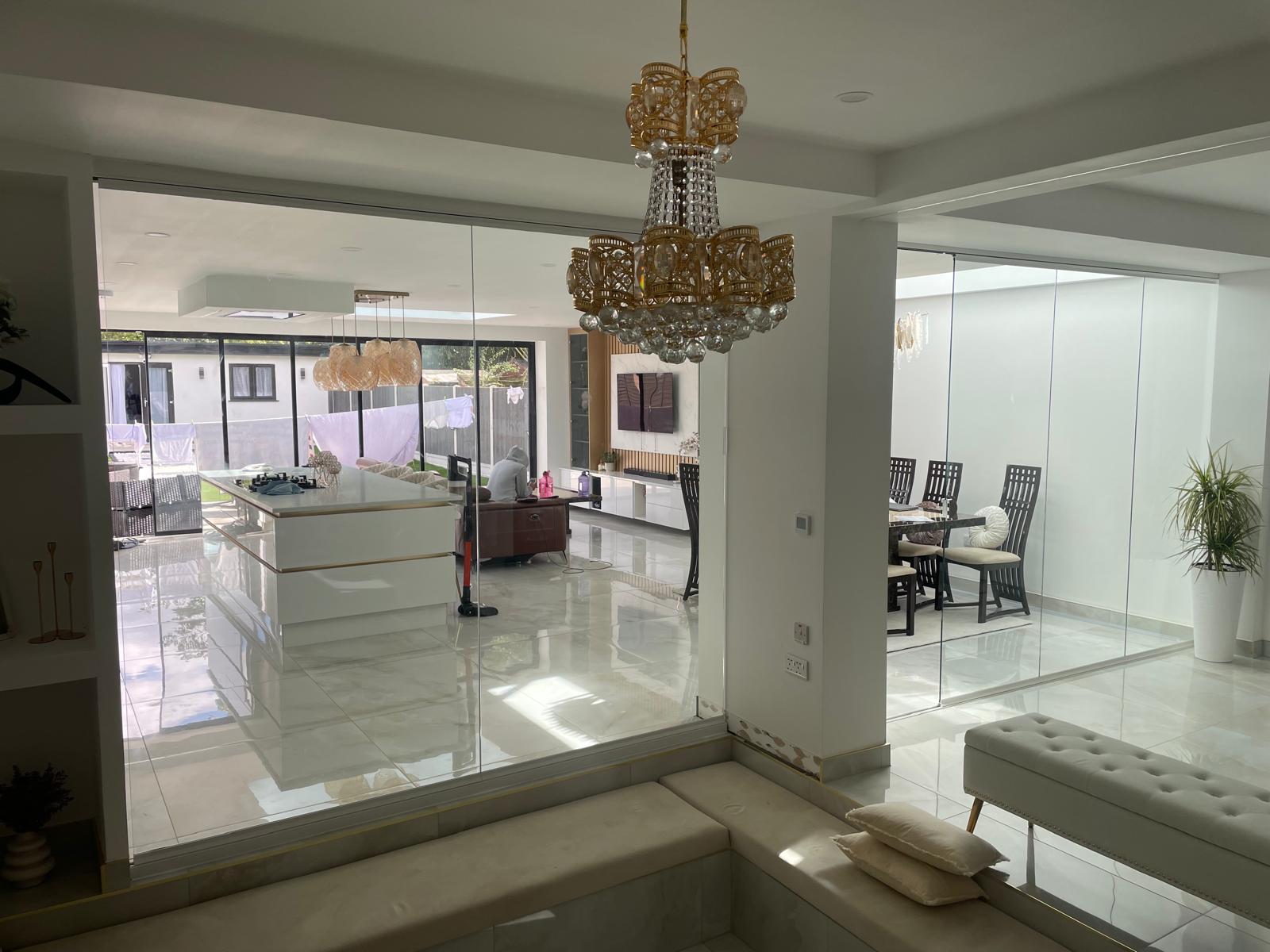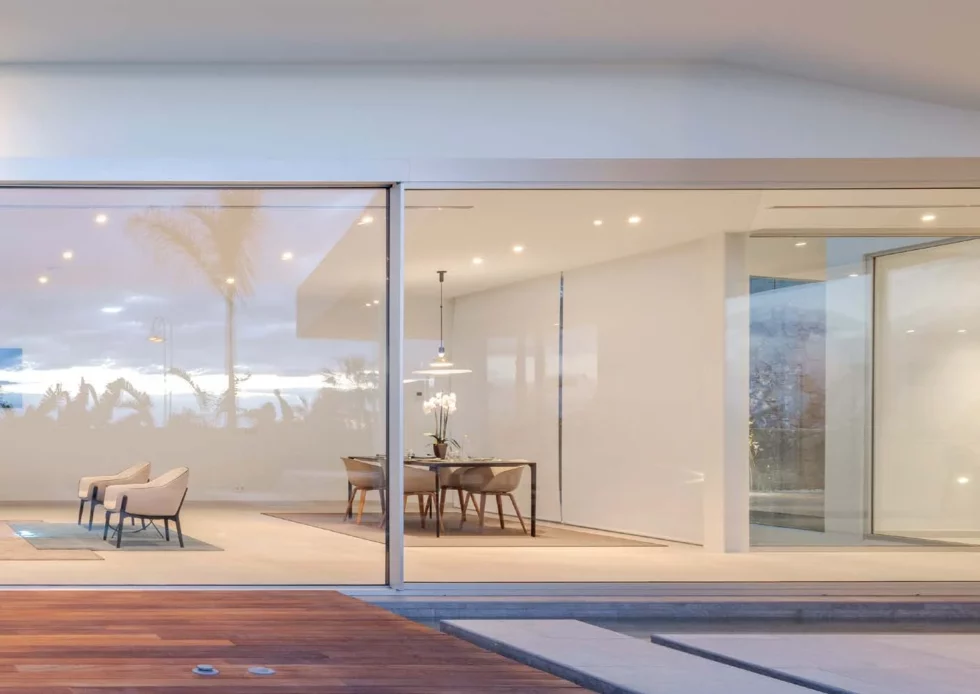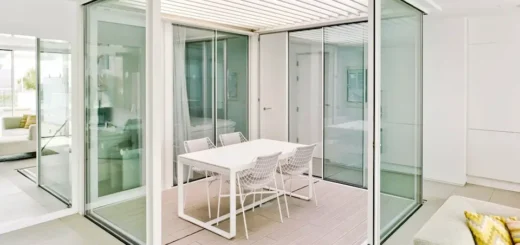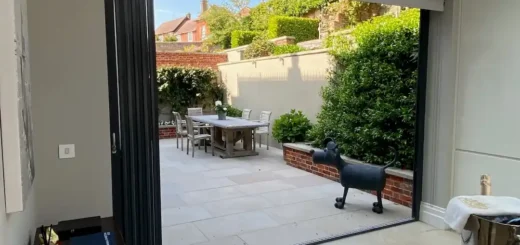Minimalist Sliding Doors: Everything You Need to Know
Table of Contents
Introduction to Minimalist Sliding Doors
Minimalist sliding doors blend form and function, creating a sleek look that suits modern homes. These doors feature expansive glass panels and slim frames, allowing more light to enter your living spaces. The design philosophy behind minimal sliding doors focuses on removing unnecessary elements, resulting in a clean and uncluttered appearance.
Slim Frames and Large Glass Panels
Minimal frame sliding doors are characterised by their slender profiles. The frames, often made of aluminium or steel, are engineered to be as thin as possible without compromising structural integrity. This design choice allows for larger glass panels, which can span from floor to ceiling and wall to wall. The result? Rooms filled with natural light and unobstructed views of the outdoors.
Typically in minimal frame sliding patio doors, glass thickness ranges from from 8mm to 12mm, and is tempered for safety and strength. Some high-end models even use laminated glass for added security and sound insulation. The combination of slim frames and thick glass creates a striking visual effect, making the doors appear almost invisible when closed.

Concealed Hardware
Minimal sliding doors often feature hidden tracks and subtle handles to maintain clean lines. The tracks are typically recessed into the floor, which not only looks good but also reduces tripping hazards.
Handle designs for minimalist sliding doors range from discreet finger pulls to flush-mounted options. Some models even incorporate electronic locking systems, eliminating the need for visible handles altogether. These thoughtful details contribute to the overall streamlined appearance of minimal frame sliding doors.
Smooth Operation
Effortless gliding is a hallmark of well-designed minimalist sliding doors. High-quality rollers and bearings ensure that even large panels move smoothly along the tracks.
The ease of use extends to the locking mechanisms as well. Many minimal sliding doors feature multi-point locking systems that engage with a simple turn of the handle. This design not only improves security but also helps to create a tight seal when the door is closed, improving energy efficiency.
Material Innovations
Advancements in materials have played a major part in the development of minimalist sliding doors. Thermally broken aluminium frames, for instance, offer excellent insulation properties without sacrificing the slim profile that defines these doors.
Types of Minimalist Sliding Doors
Minimalist sliding doors come in various styles to suit different architectural needs and personal preferences. From frameless designs to slimline aluminium options, each type offers unique benefits while maintaining a clean, modern look.
Frameless Glass Doors

Frameless glass doors represent the pinnacle of minimalist design, and use thick, tempered glass panels that move along discreet tracks without visible frames. The result is an almost invisible barrier when closed, allowing uninterrupted views and maximum light transmission.
Frameless minimal sliding glass doors usually feature small, unobtrusive clamps or patches to hold the glass in place. These fittings are often made of polished stainless steel or brushed aluminium to complement the glass. Some high-end systems even use UV-bonded glass, eliminating the need for visible hardware altogether.
For spaces where privacy is sometimes needed, frosted or smart glass options are available. These can switch from clear to opaque at the touch of a button, offering flexibility without compromising the minimalist aesthetic.
Slimline Aluminium Doors
Minimal framed sliding doors with slimline aluminium profiles offer a balance of strength and style. The outer frame of these doors is typically less than 50mm wide, providing structural support while maintaining a sleek appearance. This design allows for larger glass panels compared to traditional sliding doors, without sacrificing durability.
Aluminium’s properties as a material allows for a wide range of finishes. From powder-coated colours to anodised textures, these doors can be customised to match or contrast with your home’s architecture. Some manufacturers offer dual-colour options, allowing different finishes for the interior and exterior faces of the door.
Modern internal sliding doors often use this slimline aluminium design to create flexible living spaces. They can divide rooms when needed while maintaining an open feel when left open. The slim profiles ensure that the doors don’t dominate the space, even when closed.
Pocket Doors
Pocket doors take the concept of minimalist sliding doors a step further by disappearing completely into the wall when open. This design is particularly useful in smaller spaces where every square metre counts. When closed, these doors look like any other minimalist sliding door, but they offer the added benefit of not protruding into the room or garden space when open.
Installing pocket doors often requires some structural work to create the cavity within the wall. However, the result is a clean, uncluttered look that’s hard to beat in terms of minimalism. Some systems even allow for double pocket doors, where two doors slide into opposite walls, creating a wide opening with no visible door elements when fully open.
Corner Configurations

Corner sliding doors offer an impressive way to open up spaces, particularly in rooms with stunning views. These systems allow two sets of minimalist sliding doors to meet at a corner without a fixed post. When open, they create a large, unobstructed opening.
The engineering behind corner sliding doors is quite complex, ensuring stability and smooth operation despite the lack of a corner post. High-quality systems use precision-engineered components to achieve this feat while maintaining the slim profiles characteristic of minimalist design.
Minimal frame sliding patio doors in corner configurations are particularly popular in contemporary homes with open-plan layouts. They allow for flexible use of space, adapting to different weather conditions and social situations with ease.
Materials for Minimalist Sliding Doors
The choice of materials can have a huge effect on performance and the aesthetics of minimalist sliding doors.
Glass Options
Clear float glass is the most common choice, offering unobstructed views and plenty of natural light. For improved thermal insulation, double or triple-glazed units are often used in minimalist sliding doors. These multi-layered glass panels can reduce heat transfer, helping to keep your home comfortable year-round.
For privacy or sun control, various glass treatments are available. These include frosted and tinted options.
Frame Materials and Finishes
Aluminium is a favoured material for minimal frame sliding doors due to its strength, durability, and slim profile potential. Aluminium sliding patio doors can achieve very narrow sightlines, sometimes as slim as 20mm for interlock stiles. This material is also highly resistant to corrosion, making it suitable for coastal areas.
Powder-coated finishes offer a wide range of colour options for aluminium frames. From classic whites and greys to bold colours and wood-effect finishes, there’s a style to suit every home. Anodised finishes provide a metallic look and offer excellent durability.
For a more premium option, stainless steel frames are sometimes used in high-end minimalist sliding doors. While typically more expensive than aluminium, stainless steel offers superior strength and a distinct aesthetic.
Hardware Selection
The hardware used in minimal glass sliding doors is designed to be as unobtrusive as possible while still providing smooth operation and security. Handles are often slim and elongated, sitting flush with the door frame when not in use. Some systems even use recessed finger pulls to maintain a completely flat surface.
Roller systems are a key component in ensuring smooth operation. High-quality minimalist sliding doors use precision-engineered rollers, often with multiple wheels to distribute weight evenly. These rollers allow even large, heavy glass panels to glide effortlessly along the tracks.
Many minimal sliding doors feature a flush threshold, which looks sleek and improves accessibility. However, it’s important to note that achieving a truly flush threshold often requires careful planning during the construction or renovation process.
While not immediately visible, weatherproofing elements are also important in minimalist sliding doors. High-quality seals and gaskets ensure that the doors remain weathertight when closed, preventing drafts and water ingress. These components are carefully designed to maintain the slim profiles that define minimalist door systems while still providing excellent performance.
Using Minimalist Sliding Doors in Your Home
Minimalist sliding doors offer a range of design possibilities for various areas of your home. From creating flexible living spaces to improving natural light in bedrooms and bathrooms, these doors can change the way you experience your living environment.
Open-Plan Living Areas

In open-plan spaces, minimal sliding doors serve as elegant room dividers that don’t compromise the sense of openness. Living room internal sliding glass doors allow you to create separate zones when needed while maintaining visual continuity. For instance, you might use them to separate a dining area from the kitchen, providing the option to close off cooking odours or noise when entertaining.
White sliding internal doors are a popular choice for their ability to reflect light and create a bright, airy feel. They work particularly well in smaller spaces, helping to make rooms feel larger and more open. When open, these doors virtually disappear.
Garden-Facing Installations
Minimal sliding glass doors excel in connecting indoor and outdoor areas. By replacing a solid wall with these doors, you can create a strong visual link to your garden or patio. This design choice not only increases natural light but also makes your interior spaces feel larger and more connected to nature.
During warmer months, you can fully open these doors to extend your living space outdoors. Even when closed, the large glass panels of minimalist sliding doors provide unobstructed views, allowing you to enjoy your garden year-round. This setup is particularly effective for properties with attractive landscaping or scenic views.
Bedrooms and Bathrooms
In bedrooms, minimal sliding doors can be used to create walk-in wardrobes or en-suite bathrooms without the space requirements of traditional swinging doors. The slim profiles of these doors ensure they don’t dominate the room, maintaining a calm and uncluttered atmosphere conducive to rest.
For bathrooms, frosted or textured glass options provide privacy while still allowing light to filter through. This can be especially useful in smaller bathrooms or those without windows. The smooth operation of minimalist sliding doors also makes them a practical choice for users with mobility issues.
Home Office Design
The rise of remote work has increased the need for dedicated home office spaces. Glass office partitions using minimal sliding doors offer an elegant solution. They allow you to create a separate workspace within a larger room, providing acoustic and visual privacy when needed.
When using minimal sliding doors for home offices, look for options with good sound insulation properties. Some systems offer double-glazed panels with acoustic interlayers, helping to reduce noise transmission. This feature can be particularly valuable if you need to take video calls or concentrate on focused work while others are using adjacent spaces.
One of the key advantages of minimalist sliding doors is their space-saving design. Unlike traditional hinged doors that require clearance to swing open, sliding doors operate within their own footprint. This makes them ideal for small rooms or awkward spaces where every square metre counts. By choosing minimal sliding doors, you can make the most of your available space without compromising on style or functionality.
Choosing Minimalist Sliding Doors
Choosing the right minimal sliding doors for your home involves several factors, from accurate measurements to energy efficiency and installation methods. This section will guide you through the key aspects to keep in mind when making your selection.
Accurate Measurements
Precise measurements are essential when fitting minimal sliding doors. The process begins with measuring the opening width and height at multiple points, as walls and floors aren’t always perfectly straight. It’s also important to check for any obstructions that might interfere with the door’s operation, such as light switches or power outlets.
The thickness of your walls plays a role in determining the type of minimalist sliding doors you can install. Pocket doors, for instance, require enough wall depth to accommodate the door when it’s fully open. For exterior installations, you’ll need to account for the threshold design and any weatherproofing elements.
Energy Efficiency Factors
Look for doors with good U-values, which measure heat transfer through the door system. Lower U-values indicate better insulation properties.
Double or triple glazing can hugely improve the thermal performance of minimal frame sliding doors. Some systems use low-emissivity (low-E) coatings on the glass to reflect heat back into the room during winter months. For areas with strong sunlight, glass with solar control properties can help reduce heat gain in summer.
The frame material also affects energy efficiency. Thermally broken aluminium frames, which have a plastic insert between the inner and outer sections, provide better insulation than standard aluminium frames. This feature is particularly important in colder climates or for homes aiming for high energy efficiency standards.
Cost
The price of minimalist sliding doors can vary widely depending on factors such as size, materials, and additional features. Basic interior sliding doors tend to be more affordable, while large exterior systems with advanced glazing can be a big investment.
When budgeting for minimal sliding doors, factor in not just the cost of the doors themselves but also installation expenses. Complex installations, such as creating a pocket for pocket doors or ensuring proper weatherproofing for exterior doors, can add to the overall cost.
While it might be tempting to opt for the cheapest option, investing in quality minimalist sliding doors can pay off in the long run. Higher-quality systems often offer better energy efficiency, smoother operation, and longer lifespans, potentially saving money on energy bills and future replacements.
Professional vs DIY Installation
Installing minimalist sliding doors can be a complex process, particularly for larger exterior systems. Professional installation ensures that the doors are properly aligned, sealed, and functioning correctly. Experts can also handle any unexpected issues that arise during installation, such as uneven floors or walls.
For simpler interior doors, DIY installation might be feasible if you have good DIY skills and the right tools. However, it’s important to follow the manufacturer’s instructions carefully and ensure you have the necessary help to handle heavy glass panels safely.
About SunSeeker Doors
With over 20 years of experience, SunSeeker Doors remains at the forefront of door design with our quality-tested patio doors and related products, including the bespoke UltraSlim aluminium slide and pivot door system, Frameless Glass Doors, and Slimline Sliding Glass Doors. All of our doors are suitable for both internal and external use.
To request a free quotation, please use our online form. You may also contact 01582 492730, or email info@sunseekerdoors.co.uk if you have any questions.




